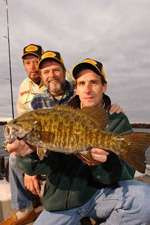Of all the freshwater black basses, the smallmouth is perhaps the most intriguing.
First, it is the most social of the eight or nine subspecies of this clan. Unquestionably, smallmouths like to school — or pack or group — living and interacting with others of their kind.
This is great news for anglers, and particularly good news to competitive bass fishermen. Find one, and in all likelihood, there will be more — and perhaps many more in the near vicinity.
But to the angler’s chagrin, smallmouths also tend to be here today and gone tomorrow — or gone just a few hours later.
These are just the beginning of a long list of behavioral quirks. Quirks that can throw anglers for a loop and ones we will explore in coming articles.
The smallmouth bass is a critter of deeper and cooler rock-ridden streams and rivers. If available, smallies like current and a solid bottom to boot, yet they are equally at home in lakes — even very big ones. These bodies of water, like the rivers which many times feed them, are usually cooler, deeper and again often rocky as well. While smallmouth bass often make extensive use of weeds, you can be assured that a platform of harder bottom is nearby.
The smallmouth bass is primarily what is called a niche fish. In other words, it is seldom a single top-of-the-line predator. In most cases, it shares space and food with other fish like walleye, largemouth bass, muskie and pike. And again, this has great ramifications on where they are and what they are doing during any seasonal timeframe.
Living in environments like these, the brown bass has developed some very unique coping skills. These attributes make its movement patterns, feeding cycles and prey preferences often difficult to predict.
In large bodies of water, or large rivers, we have tracked large aggregations of bass, usually following some sort of seasonal progression. These schools, groups and pods loosely move together, and then split up into smaller groups or pods to graze, only to re-organize some place further away. In rivers, they might move (en masse) a mile or more in a day. In lakes we have tracked them up and down, and at times suspended in between, from two feet deep to 20 feet deep in a matter of a couple of hours.
Besides being a social animal, the smallmouth is among the most curious of all the basses. Our television cameramen and divers have called the fish in close by clicking rocks together. They will swim up close and personal to the camera. Our friend and fellow TV producer Kim Stricker (Hook & Look) has had similar experiences.
While at times being bold, aggressive, and showing themselves to be present in an area, they also have a bad habit of sometimes becoming mind-boggling shy — sometimes grabbing a nice fat live redtail chub, but ignoring every lure in your tackle box. This phenomenon can encompass a morning of crazed artificial lure action, to an afternoon of frustrated lure-changing, only to experience a “turn-on” a few hours later.
The use of underwater cameras and divers has documented this anomaly time and time again. We have abundant video footage of numbers of fish lying near each other, yet in a totally unresponsive state. It is this kind of behavior that makes fishing for smallmouth bass not only challenging, but addictive.
When you add the smallies’ penchant for suspending — a little-known and even less understood phenomenon by the vast majority of anglers — the fish becomes one of the most worthy of opponents. And a fish, which as a group, the Lindner family has been tracking for nearly a half a century.
Exploring the variety of habitats that smallies live in, and the methods to deal with the seemingly contrary behavioral patterns, is an exciting journey we cannot begin to exhaust in the broad range of the smallmouth’s life cycle in a year — or a even a decade — of articles like this one.





